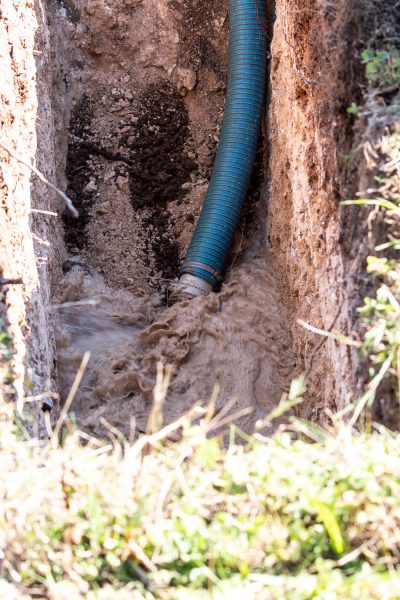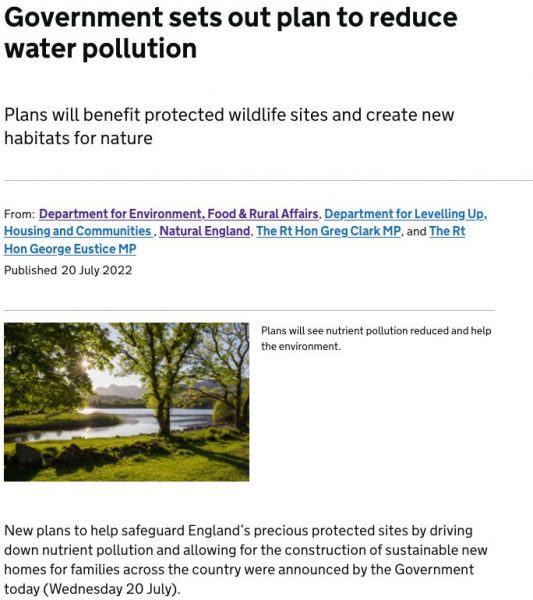Ripping up the nutrient neutrality red tape
Geoenvironmental • Industry matters • Regulation
The new Prime Minister, Liz Truss, promised during her recent leadership election, to deliver “sweeping reforms to planning legislation”. This would be achieved through amendments to the new Levelling Up and Regeneration Bill [currently in the committee stage] which would see better new housing delivery, red tape “ripped up”; investment zones with simplified planning regimes and EU red tape and nutrient neutrality rules “scrapped”.
Bold electioneering statements, but what is the reality?
The Home Builders Federation has said that the construction of around 120,000 new homes in England are being delayed because of Natural England’s overestimation of the impact of new developments on nutrient pollution, which has resulted in around 74 Local Planning Authorities (LPA) across putting planning applications on hold.
Why delays?
The difficulty has been that the LPAs needed to understand what conditions they can impose now to achieve them. Due to issues with mitigation processes, this placed an effective moratorium on planning decisions for developments in the affected areas.
The financial impact
These delays, added to the significant financial burden of nutrient pollution mitigation placed on developers [estimated at £5,000 per house] has seen a large number of developers go to the wall. Figures published under Freedom of Information legislation, have shown 360 insolvencies in the house building sector for the year up to March 2022, which is a 75% increase on the 209 recorded in 2020-21.
 A possible solution
A possible solution
Prior to the Conservative Party leadership election; in July the Secretary of State for Environment, Food and Rural Affairs issued a statement that outlined proposed measures to tackle water quality. They included amendments to the Levelling Up and Regeneration Bill including: “A further package to tackle nutrient pollution, which is a significant problem for our freshwater habitats and estuaries.”
He said: “In accordance with complex and bureaucratic EU-derived domestic legislation and case law, Local Planning Authorities can only approve a plan or a project if they are certain it will have no negative effect on the site’s integrity. Natural England, in its statutory role as an adviser on the natural environment, has advised a total of 74 Local Planning Authorities on the nutrient impacts of new plans and projects on protected sites where those protected sites are in unfavourable condition due to excess nutrients. They have issued tools and guidance on an approach called ‘nutrient neutrality’ to mitigate the impact of nutrient pollution so that development can go ahead. However, there is still a gap in the ability of LPAs and developers to find mitigation quickly and effectively.
“In order to drive down pollution from all development in the relevant catchments, we will be tabling an amendment to the Levelling Up and Regeneration Bill. This will place a new statutory duty on water and sewerage companies in England to upgrade wastewater treatment works to the highest technically achievable limits by 2030 in nutrient neutrality areas. Water companies will be required to undertake these upgrades in a way that tackles the dominant nutrient(s) causing pollution at a protected site. We are also using feedback from the recent ‘call for evidence’ to water companies to identify where these upgrades could be accelerated and delivered sooner. Our proposed Environment Act target to tackle wastewater pollution across the country will still see upgrades brought in elsewhere, on a slightly longer timeframe.
“In the meantime, we know the impact of new housing is a small proportion of overall nutrient pollution, but mitigation requirements have a significant impact on overall house building. This amendment will improve water quality and in doing so will support housebuilding to continue in areas affected by nutrient pollution.
“Building on our initial package of support announced in March 2022, I will issue a ministerial direction to support Natural England to establish a Nutrient Mitigation Scheme. Natural England will develop the scheme, working with Defra and DLUHC [Department for Levelling Up, Housing & Communities]. Defra and DLUHC will provide funding to pump prime the scheme: this is intended to front load investment in mitigation projects, including wetland and woodland creation. This will then be recouped through a simple payment mechanism where developers can purchase ‘nutrient credits’ which will discharge the requirements to provide mitigation. Natural England will accredit mitigation delivered through the Nutrient Mitigation Scheme, enabling LPAs to grant planning permission for developments which have secured the necessary nutrient credits.”
“Natural England will deliver the scheme by establishing an ‘Accelerator Unit’, with the support of Defra, DLUHC, the Environment Agency and Homes England. The previous announcement of £100,000 funding from DLUHC for affected areas will help support delivery of the scheme. We will open the scheme to all developers while ensuring that small and medium enterprises are prioritised, given the difficulties they can face in securing mitigations due to access to funds and skills.
“We will announce further details in the autumn when the scheme will launch, and in the meantime, Natural England will be in touch with local authorities and developers. Our amendment will support the delivery of the tens of thousands of homes currently in the planning system, by significantly reducing the cost of mitigation requirements. The mitigation scheme will make delivering those requirements much easier for developers.”
 New variables
New variables
Developing the new scheme will require LPAs to prepare revised nutrient neutrality strategies. The four-stage process for determining a nutrient budget will remain largely the same. However, the new generic methodology introduces the following new variables at stages two and three of the methodology in relation to leaching rates:
- Operational catchment
- Soil drainage type
- Average annual rainfall
- Whether the site is within a Nitrate Vulnerable Zone (NVZ).
These new variables will impact hugely on the leach rate kg/ha of nitrate and phosphate for each of the individual land use types.
On-sight mitigation options
It is possible to achieve nutrient neutrality on-site, via the creation of large-scale wetlands, woodlands and fallow habitats. However, in practice, this is unlikely, unless there is a significant open space provision within the development boundary, as neutrality measures are often very onerous and land-hungry. Solutions need to be available and work in perpetuity or at least for as long as the development is required, which is a heavy burden on developers. Packaged private water treatment plants are one solution, but require material investment in front end infrastructure before other development can take place.
 A step in the right direction…But!
A step in the right direction…But!
While the new measures promise to achieving the long-term goal of nitrate neutrality and prevent it creating further backlogs in home building, the Levelling Up and Regeneration Bill still has a long way to go on its journey through parliament and the amendments concerning nutrient neutrality and planning reform are likely to anger the green lobby and so are not guaranteed to reach the Royal Assent stage.
Nutrient trading schemes (nutrient credits) are likely to provide the solution, but timelines on when these will be rolled out are at best vague and until they are implemented, site-based schemes will continue to be the best and only option for developers. Albeit one that remains onerous, costly and land hungry as outlined above.
How can Ground & Water help?
Determining the nutrient budget for a site requires a phased approach to evaluate soil types, drainage, and geoenvironmental factors. Our industry leading solutions and experience working within one of the UK’s largest Nitrate Vulnerable Zones, can help you navigate the minefield that is nutrient neutrality.

